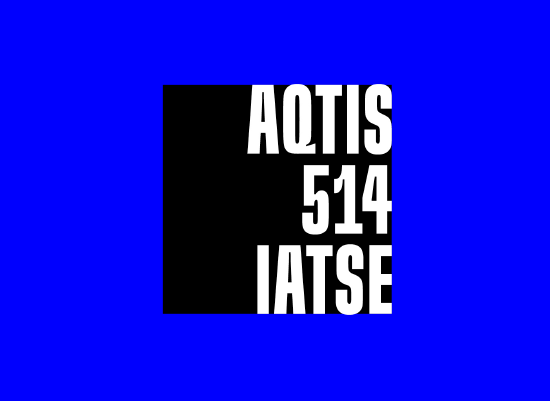Moving forward together
The AQTIS 514 IATSE was born out of over 45 years of struggle from audiovisual technicians who rallied to establish an organization to defend their interests.2021

The merged organization is established on January 1, 2021 under the name AQTIS 514 IATSE.
2020
After informal talks, AQTIS, IATSE 514 and IATSE 667 began discussing a merger. They wanted to join forces in order to:
- Improve member services
- Improve working conditions for members
- Uphold Quebec’s distinctiveness of each technician group
- Increase the number of local and foreign productions in Quebec
An agreement in principle is reached in August 2020 and, in a secret ballot vote, the members ratify it by 83%.
2019
After several failed bargaining attempts, technicians called a one-day strike on August 29, 2019. The main demands are: a catch-up raise, guaranteed contracts, a professional training fund, a fund to support preventive maternity leave, and an occupational health and safety program.
2015 to 2017
AQTIS signs a new collective agreement with the AQPM. For the first time, more than 150 functions are officially recognized by the producers. The agreement also aimed to improve working conditions. This was followed by a long struggle with the provincial and federal governments to increase budgets for television and film productions.
2012
AQTIS undertook a restructuring of its services. It is involved in first collective agreement arbitrage, its area of expertise. Its services to members have made it stronger and more unified.
AQTIS represents over 6,000 creative artists, craftspeople and technicians in at least 150 different occupations related to set design, make-up, hair styling, camera, sound, scripts, technical effects and lighting, editing, control room, logistics, post-production, TV control room and TV production.
In 2014, the Labour Peace Agreement came to an end, opening the door to inter-union poaching.
2008-2009
In the summer of 2008, the two unions finally reached an agreement, and in September of that same year, they signed a temporary agreement limiting IATSE's jurisdiction to certain sectors of American productions, while awaiting the adoption of legislative amendments expected in the Spring of 2009.
2005 to 2008
At the end of 2005, some technicians took advantage of this situation and decided to open a local chapter of the International Alliance of Theatrical Stage Employees, Moving Picture Technicians, Artists and Allied Crafts (IATSE), which consequently jeopardized the industrial peace of American productions shot in Quebec.
A series of negotiations followed in an attempt to reach an agreement between the two associations, under the supervision of a government-appointed mediator. However, the parties were unsuccessful in finding a solution. The IATSE filed an application with the Labour Relations Commission (LRC) to become the technicians' union representative. In response, AQTIS defended its exclusive recognitions. The conflict went to court, and opposed the two Quebec laws governing union representation.
In February 2007, threatened with massive job losses as a result of American producers being too afraid to film in the province, the Government of Quebec was asked to become directly involved in resolving the conflict created by the existence of two competing laws. The government struck a committee to prepare an update on the legislative context in order to restore peace in Quebec's film and television industry.
2004

Technological progress rendered the separation of production types by platform obsolete, which led to the two technicians’ associations merging in 2004, thereby creating the Alliance québécoise des techniciens de l’image et du son (AQTIS).
The merge proved to be more complex than anticipated, and the new association had difficulty encouraging the technicians and employees of the two former associations to unify. Furthermore, there was a dramatic collapse in the number of productions, which up to that point, had been constantly increasing. This was a financillay challenging year for technicians and the association.
1983
In 1983, the members of the two associations – the APCQ and the SNC – decided to merge under the name Syndicat des techniciens du cinéma du Québec (STCQ), and to leave the CSN. In early 1987, a new agreement, who was remained a civil contract, was signed with the APFTQ. Not long after, the STCQ added video to its business activities, becoming the Syndicat des techniciens du cinéma et de la vidéo du Québec (STCVQ).
By the end of that year, under relentless pressure from the Union des Artistes, the Government of Quebec realized that it was impossible for self-employed workers in the performing, recording and film industries to have their rights recognized under the Labour Code, and brought in the Act Respecting the Professional Status and Conditions of Engagement of Performing, Recording and Film Artists. This became known as the Status of the Artist Act. It allows technicians to be recognized as artists and to require producers' associations to negotiate agreements with the associations representing the various categories of artist.
In July 1989, the STCVQ was recognized as an artists' association for the film production industry by the Commission de reconnaissance des associations d’artistes et des associations de producteurs (CRAAAP). Initially, 16 artist occupations were recognized, out of the 65 listed on the application.
In 1991, technicians working on a set that wasn't linked to a film did not feel represented by the STCVQ and thus founded the Association des professionnels de la vidéo du Québec (APVQ). In July 1993, the APVQ was recognized by the CRAAAP for the video production sector. The CRAAAP thereby limited the scope of associations’ jurisdiction by using the platform as the reference.The APVQ signed its first collective agreement with the APFTQ in August 1996.
1976
The technicians reacted in 1975 by attempting to impose a collective agreement on all producers. A series of actions followed that aimed at forcing producers to sign SNC contracts. Not everyone was happy with this position, and in 1976, some of the members founded the Association des professionnels du cinéma du Québec (APCQ), which mainly covered advertising for English-language productions and for co-productions.
That same year, the SNC finally signed a first collective agreement with the APFTQ. This was a civil agreement as labour laws proscribed standard accreditation for self-employed workers. Meanwhile, the SNC affiliated itself with the CSN in order to benefit from specialized labour relations services. The collective agreement was renewed in 1979.
In the following years, the situation on-set became quite difficult – the presence of two unions and the notion of set majority opened the door to a multitude of licensees and new members. In addition, numerous producers who were not APFTQ members worked without an SNC contract, threatening the fragile balance of power between producers and technicians. Production also declined, leading to difficult periods of unemployment for some, on top of paying costly membership fees.
1970
1970 saw the creation of the Syndicat national du cinema (SNC), a union representing freelance technicians. It was incorporated under the Quebec Professional Syndicates Act. The first collective agreement was signed with an American producer. Supported by the Fédération québécoise de l’industrie du cinéma, the newly established SNC recognized the need for strong local representation of technicians in order to counter attempts by the American unions to establish themselves in Quebec.
What followed was a series of piecemeal agreements due to the fact that the negotiating regime established by the Labour Code did not provide for accreditation to negotiate a single agreement with all producers.
In 1973, the SNC undertook to negotiate a collective agreement with the Association des producteurs de film du Québec (APFQ). This negotiation was terminated by the APFQ in 1974, and no agreement was signed.
1963
A first association, the Association professionnelle des cinéastes (APC – professional film-makers' association) was established in 1963. This led to the first union accreditation, for the Syndicat général du cinéma et de la télévision, under the federal Public Service Labour Relations Act. This accreditation covered only the activities of the National Film Board (NFB).